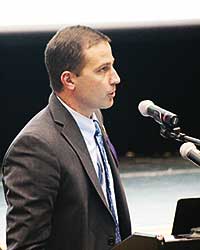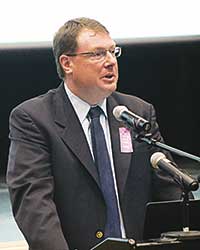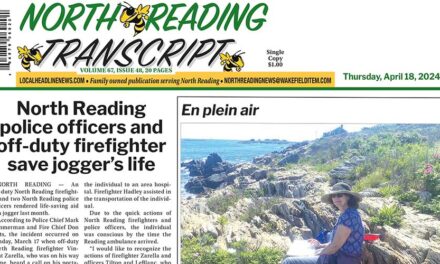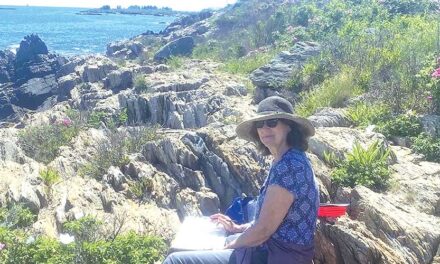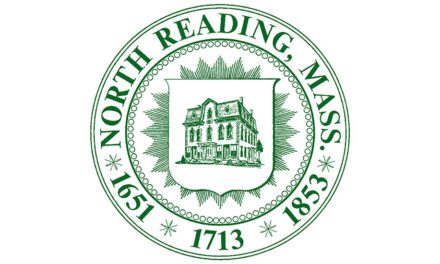Published in the October 18, 2018 edition
By MAUREEN DOHERTY
NORTH READING —The name change transforming the “Board of Selectmen” to the “Select Board” and the word “Selectman” to “Select Board Member” was signed into law late last Friday by Gov. Charlie Baker, after both the Senate and House also endorsed the change initiated at the annual Town Meeting last June.
The action followed the approval of the name change by the AG’s municipal law unit in mid-September enabling the Home Rule Petition to make the appropriate changes throughout the Town Charter and other pertinent documents.
The new terminology was used officially for the first time at Monday night’s October Town Meeting as staffers scrambled to change the verbiage on PowerPoint slides before the meeting and many town documents will now need to be updated. Old habits will be hard to break. Town Moderator John Murphy corrected himself several times when referring to a member of the board as a “selectman” at the meeting.
This session of Town Meeting also had its share of feisty debates even though just 124 voters showed up to take action on the 22 warrant articles.
Bike path study
One such debate was for a $55,000 expenditure under Article 18 to fund feasibility study for a pedestrian/bicycle pathway along the abandoned railroad bed in the town center near Ipswich River Park and to points west toward Wilmington and east toward Lynnfield to join with other paths or future paths.
After a debate on the merits of spending the funds now on a project that may take decades to complete, the voice vote was too close to call, so Murphy requested a hand count and it carried 65-34.
The cost is being paid from Free Cash. Its chief sponsor is Phil Hertz of 105 Park St. who has spent years researching it.
“A recreational path in the town has been a topic for close to 50 years. The concept would be to run a recreational path, which would be used for biking, walking, running; in the winter, snowshoeing, skiing, from the Lynnfield town line to the Wilmington town line,” he said.
“The path will follow the old Salem to Lowell railroad line, which is also the Peabody bike path, where Peabody, Middleton and North Reading come together. It runs effectively from North Reading all the way to Salem and then also connects into the Danvers/Topsfield bike path that goes up to Georgetown. The gap would be in Lynnfield,” he said, explaining that stretch would traverse Lynnfield Center Water District land that is currently not open to public uses, but one day it could be. The path has the potential to go all the way to the ocean in Newburyport.
The challenge in piecing this path together is the fact that the portion of the railroad land that passed through North Reading had ceased to operate more than 100 years ago so some land was sold to private landowners. However, since much of it passes along the Ipswich River or through swaths of wetlands that are essentially unusable to those private landowners, options exist in which raised boardwalks could be built above the wetlands in the areas where easements would be requested. This model has been used throughout the country and allows users to access recreational land areas for that are currently inaccessible because it is too wet.
Hertz also explained that the construction cost is paid through federal transportation grants from funds earmarked out of the federal gasoline tax to which everyone contributes for this purpose. Once the plan is accepted it is the state that administers those federal funds, so the town would not have additional obligations. There are also other grants available to assist communities in getting their projects through the engineering stage, but none of those are accessible until the feasibility study is completed.
“The land is owned by 15 or 16 different landowners; the town of North Reading owns about one-third of it, there are a few businesses, the Postal Service owns some, New England Electric owns some, and there are a number of homeowners,” Hertz said. This study will assess the route and enable them to talk to homeowners and business owners. “In most cases it doesn’t follow the rail bed, it follows the Ipswich River and Martins Brook.”
An added bonus is the increase in property values in those communities that have built such paths as it is considered an amenity. Hertz said the land use agreements would be “worked out collaboratively” and this plan does not include eminent domain, but there could be some “compensation” involved.
While the Select Board voted to support the study, the Finance Committee did not, with one abstention, based on the number of other major projects and financial obligations facing the town.
“Part of it was although $55,000 will not break the bank, assuming that the town moves forward with the bike path there are upwards of $200,000 to $300,000 in engineering costs before we can put in an application” for grant funds, said FinCom Chairwoman Abby Hurlbut. “Intellectually we all understood a bike path would be great, we also felt that there were some other projects that we are already involved in that were using a ton of the town’s money, and in addition we also felt one of the things we should look at more than a bike path was a community center.”
“I think this is a nice idea but we simply can’t afford to do it,” Fin Com member Don Kelliher said.
“In North Reading we certainly have not been at the forefront of bike trails and recreational trails like so many other communities. There is a reason a portion of the gas tax and the state and the federal government have decided to fund these trails. It is because it adds such a terrific amenity to a community. In every bike trail that I have been involved with throughout the state, it has increased the property values of those places through which the bike trail travels,” commented Diane Norris, 240 Elm St.
“But I would take issue with the FinCom’s recommendation that they need to focus on the community center. You have to do things simultaneously. This is just a feasibility study. This just lets you know is it even worth proceeding… and also a community center. I, for one, would take advantage of both and I’m not interested in not having both. I think we should investigate what is going to be available to the town, not just for the current time, but for the future time. People are looking to come to North Reading. They are looking to take advantage of all that we have to offer. Right now we have great schools to offer and we have great athletic fields. It’s time we expand, and I would certainly support this $55,000,” Norris said.
Warren Pearce of the Community Planning Commission (CPC) said his board does think it would be a “great idea to have this bike path,” noting the support the CPC has given to open space plans in the past. However, the members do have some reservations about spending this money at this time for this purpose. If they had an extra $55,000 to spend they would prefer to see it go toward a sidewalk for Central Street, for example, to promote safer access to Ipswich River Park from the north side of town. “We put all this money into Ipswich River Park; if no one can get there safely, what’s the point?” Pearce asked.
Kelliher, of the FinCom, said he was one of the board members who voted against it because he didn’t think the town could afford it. “There are a lot of things on our plate that need to be done. This falls into the category of something that we would like to have, want to have, but we don’t need to have. We need to have roads that are in good repair. We need to put some serious money into our library building. We need to put serious money into Town Hall or replacing the Town Hall. There are things that we have to do in this town; this is not one of the things we have to do, $55,000 is just the tip of the iceberg. Why spend $55,000 on a feasibility study for a project (when) we probably can’t afford to spend $300,000, $400,000, $500,000 before there is a shovel in the ground and we need to apply to the state and federal government for a grant that we hope that we’ll get?” Kelliher asked.
“Part of the feasibility study is to come up with what is easy and what is hard. We will probably come up with phases — maybe two phases or three phases. Maybe the phase in the middle near Ipswich River Park would involve a lot less land and construction, so perhaps we could apply for a grant for a mile or a mile and a half in the middle… We need to get the plan and then we can figure out how long it takes us to do it,” Hertz said.

